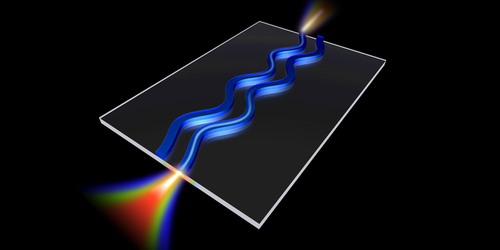Curved Light Channels Have Better Coupling
Optical circuits use waveguides to guide light to specific destinations. Light injected into one waveguide can also propagate along an adjacent one because of an effect analogous to that which causes a kitchen table to rattle in unison with a jackhammer vibrating on a nearby street. Although the effect is well known, creating robustly coupled waveguides that transmit their signals without loss to the environment remains difficult, particularly in miniaturized circuits. Now Wange Song of Nanjing University, China, and his colleagues experimentally demonstrate loss-free coupled waveguides that operate over a broad wavelength range [1]. The design, which uses curved waveguides instead of straight ones, could provide efficient, flexible optical-signal routing on silicon chips.
The team created their waveguides by etching a pair of parallel channels into a silicon surface. The waveguides were 1 𝜇m wide, 35 𝜇m long, and 600 nm apart. In one sample the waveguides were straight, in another, wavy. The researchers shone multifrequency light beams into the left waveguide of each pair and measured the range of frequencies of light that propagated down both.
Song and his colleagues found that, for the wavy sample, light propagated down both waveguides. That light contained all the frequencies of the original beam, a result indicating lossless coupling. In contrast, for the straight sample, only one frequency of light emerged from the right-side channel, indicating signal loss.
Compared to straight waveguide designs, the team found that their wavy one offers an order-of-magnitude improvement in the range of frequencies of light that can be transmitted and is robust against minor structural variations. They say that, as well as working for two wavy waveguides, the method should be scalable to hundreds of densely packed ones.
–Rachel Berkowitz
Rachel Berkowitz is a Corresponding Editor for Physics Magazine based in Vancouver, Canada.
References
- W. Song et al., “Dispersionless coupling among optical waveguides by artificial gauge field,” Phys. Rev. Lett. 129, 053901 (2022).




